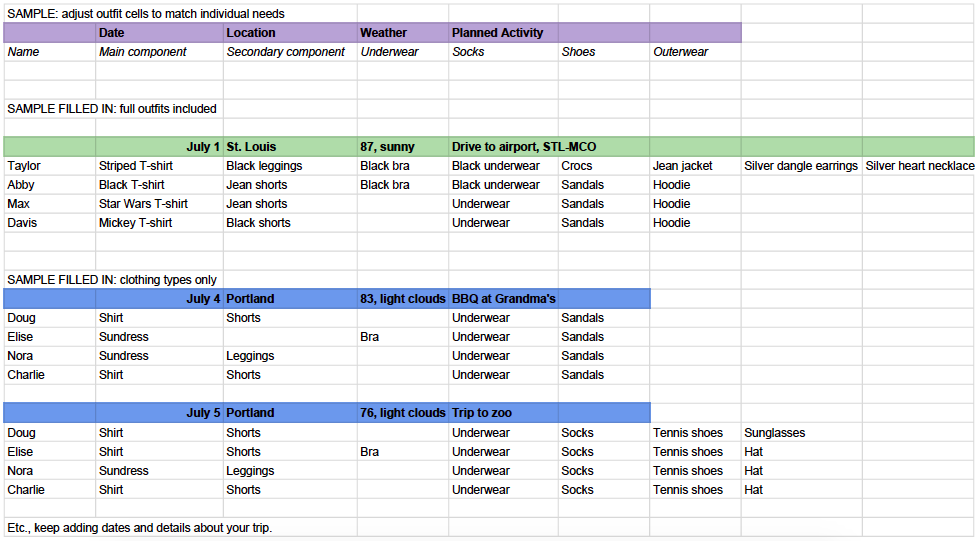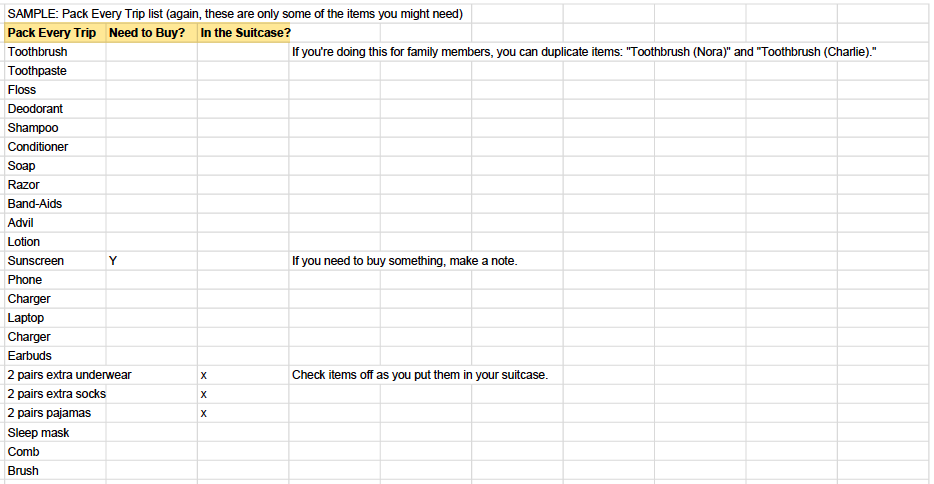When’s the last time you went on a holiday and felt confident that you’d packed everything you needed? For some of us, travel means spending the first night away from home at a Kmart or Big W, buying the sunscreen or thongs (or jacket and thermals) we should have put into our suitcases.
I used to spend hours packing, trying to remember everything I needed: shampoo, extra pairs of underwear, pyjamas. I left myself notes the night before a big holiday, reminding me to pack my toothbrush the next morning instead of leaving it in the bathroom.
But several years ago I started packing differently. Instead of coming up with a new packing list every time I went on a trip, I created a spreadsheet template that I called my “outfit grid.” It was originally created to help me decide what outfit to wear on every day of vacation. Now it helps me remember all the things I usually forget to pack, and ensures I have everything I need before I walk out the door.
[referenced url=”https://www.lifehacker.com.au/2017/04/how-to-pick-the-perfect-travel-shoes-for-your-adventures-around-the-world/” thumb=”https://i.kinja-img.com/gawker-media/image/upload/t_ku-large/sa4cij53tfattewl1sff.jpg” title=”How To Pick The Perfect Travel Shoes For Your Adventures Around The World” excerpt=”Epic journeys call for top-notch footwear that can handle anything. You need a pair of shoes that are so comfy, protective and versatile you won’t even think about them the entire trip. Here’s what you need to know before you go.”]
How the Packing Grid Works
My packing grid is divided into two sections. The left-hand side lists every day I’m going to be away from home, as well as any planned activities and weather predictions.
Underneath each day, I write out everything I’m going to wear. If you follow me at The Billfold, you might have seen me explain my grid with this graphic:

By “main” and “secondary” component, I mean “shirt and pants” or “dress and tights”. I also factor in any jackets or coats I might need, as well as shoes and jewellery.
You might find it overwhelming to plan out every component of every day’s outfit, down to the underwear, but at least I know I’ll have enough underwear for every day of the trip — and none of it will be the wrong colour or style for what I’m planning to wear.
Making this grid also helps me pack lightly; do I really need that extra pair of shoes if I’m only going to wear them once? Can I re-arrange my outfits so I only need one pair of jeans, or one jacket?
But the real magic of the packing grid is what happens on the right-hand side. That’s where I list the stuff that I need on every trip, regardless of where I’m going: toothbrush, toothpaste, sleep mask, phone charger and so on.
The packing grid helps me remember to pack the stuff I use every day — I check off each item only when it goes in my suitcase, which means that I can’t check off “toothbrush” or “deodorant” until the morning I leave — and the grid also works to catch those items that I don’t use every day but still don’t want to forget: Band-Aids. Paracetamol. An umbrella.
The right-hand column can also be copy/pasted into my next packing grid, since it rarely changes. I’m going to need earbuds, I’m going to need an extra pair of socks and I’m going to need Band-Aids at some point so I might as well toss a few into my purse.
That’s how the packing grid works for me and how it might work for you if you’re packing for one.
How the Packing Grid Can Work for Families
I’m guessing that not everyone in your family is going to be as excited about planning every outfit in advance as I am. But the basic fundamentals of the left-hand side of the grid still apply: if you list every day you’ll be gone, the weather and the planned activities, you’ll probably have a good sense of what clothing to pack and how much of it.
Even if you don’t go full daily-outfit-planner, you could fill out your grid with the types of clothes you’ll need every day: “shirt and shorts” or “shirt, shorts, swimsuit, coverup”. Anything you think you and your family members — especially kids — might wear on every day of your vacation. Then you can count everything up: does my son have five T-shirts in his suitcase?
The right-hand side of the grid is where this packing checklist is really going to shine. You’ll make your Pack Every Trip list, and then copy it into every future packing grid. All of the sunscreen bottles and wet wipes and iPad chargers only need to get written down once, and you’ll have a checklist you can refer back to for every subsequent vacation.
Yes, you might need to add special one-trip-only items to your packing grid and you’ll definitely need to update this list every once in a while, especially as your kids get older and their needs and interests change. But having a packing master list can save a lot of time and stress — not to mention emergency trips to Target.
Camps often include checklists of what to bring (and what not to bring) and those checklists can go straight into the grid as well. You can even add another two columns: “already own” and “need to buy before camp” .
Your Packing Grid Template
At this point, you probably want a packing grid template of your own — right? I’ve gone ahead and started one for you, which you can view below. I made this template “family-sized”, but you can scale it up and down depending on how many people you’re packing for.


When it comes time to pack, remember that everything on your grid must go into your suitcase — and when it’s time to leave your hotel/campsite/parents’ house, you can check your grid again to make sure everything you brought went back into your suitcases.
When I tell people that I pack according to a grid, they often ask how much “extra time” it takes, or what happens if my travel plans change. If I’m planning for an upcoming trip, it takes me about ten minutes to fill out my grid, decide what I’m going to wear, add an extra outfit in case I need it and update the Pack Every Trip list.
Your grid might take longer to fill out, especially if you’re packing for multiple people, but it’s still better than carrying all of that packing information in your head, right?
And if your travel plans change: well, it helps to have an extra outfit, and I’ve washed underwear in the hotel sink, and on my last trip I did make an emergency run to Big W to get something I hadn’t realised I would need. It happens to the best of us — but with a packing grid, it happens much less often.

Comments